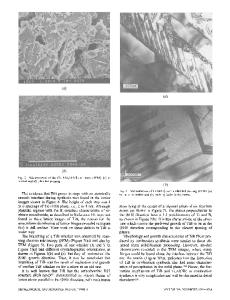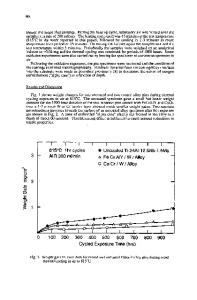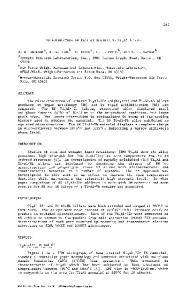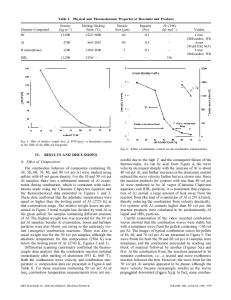Combustion synthesis of cubic Al 3 Ti alloys
- PDF / 924,131 Bytes
- 6 Pages / 612 x 828 pts Page_size
- 51 Downloads / 327 Views
Combustion synthesis of elemental powder compacts has been used to produce alloys with compositions corresponding to Al3Ti, Al73Ti24Cr3, and Al67Ti25Cr8. The binary composition exhibits a strong exothermic reaction at ~665 °C, resulting in formation of single phase Al3Ti with the tetragonal D022 structure. The heat of formation of the compound at 298 K, A//°(298), was estimated from peak reaction temperature measurements to be —35.0 kj mol" 1 . Additions of Cr lowered the reaction initiation temperature and resulted in the formation of intermediate products attributed to Al-Cr reactions. The D022 structure remained the primary reaction product in Cr-containing alloys. The Cr particles did not completely dissolve during initial reaction; an additional heat treatment at 1200 °C or above was required to homogenize the material, resulting in partial or complete transformation of the DO22 structure to the cubic L l 2 structure, depending upon Cr content. Homogenization at 1250 °C for 4 h produced material consisting approximately of a 50-50% mixture of the DO22 and L l 2 structures for Al73Ti24Cr3, and 100% L l 2 for Al67Ti25Cr8. In all cases, reaction at ambient pressure was accompanied by swelling, resulting in final densities less than 60% of theoretical. Application of external pressure, either during or subsequent to combustion synthesis, produced near theoretical density materials exhibiting a homogeneous and equiaxed microstructure.
I. INTRODUCTION Alloys based on the intermetallic compound Al3Ti are attractive candidates for structural applications at elevated temperature because of their low density, high melting point, and excellent resistance to oxidation. Binary Al3Ti has an ordered tetragonal crystal structure (DO22) that is thought to be intrinsically brittle because there is an insufficient number of slip systems to be compatible with extensive plastic flow. It has recently been demonstrated that addition of fourth period transition elements to Al3Ti results in transformation of the tetragonal structure to the cubic L l 2 structure.1"5 While significant room temperature tensile ductility has not yet been demonstrated for these alloys, the cubic structure has a sufficient number of slip systems for plasticity. Hardness and compression testing have indicated that material having the cubic structure exhibits greater ductility than that having the tetragonal structure.2"4'6'7 Cubic Al3Ti alloys have been fabricated by conventional casting,4'6 melt spinning,8 solid state processing of elemental powders,9'10 and plasma deposition.3 According to the binary phase diagram, shown in Fig. I, 11 Al3Ti is a line compound, exhibiting little or no range of solubility. Thus, fabrication of dense, homogeneous, single phase material suitable for mechanical property evaluations has been difficult.4'6'10 As a result, most castings and powder products have been subjected to hot pressing or hot isostatic pressing (HIP) treatments during
or subsequent to initial processing in order to eliminate segregation, pores, and other d
Data Loading...











